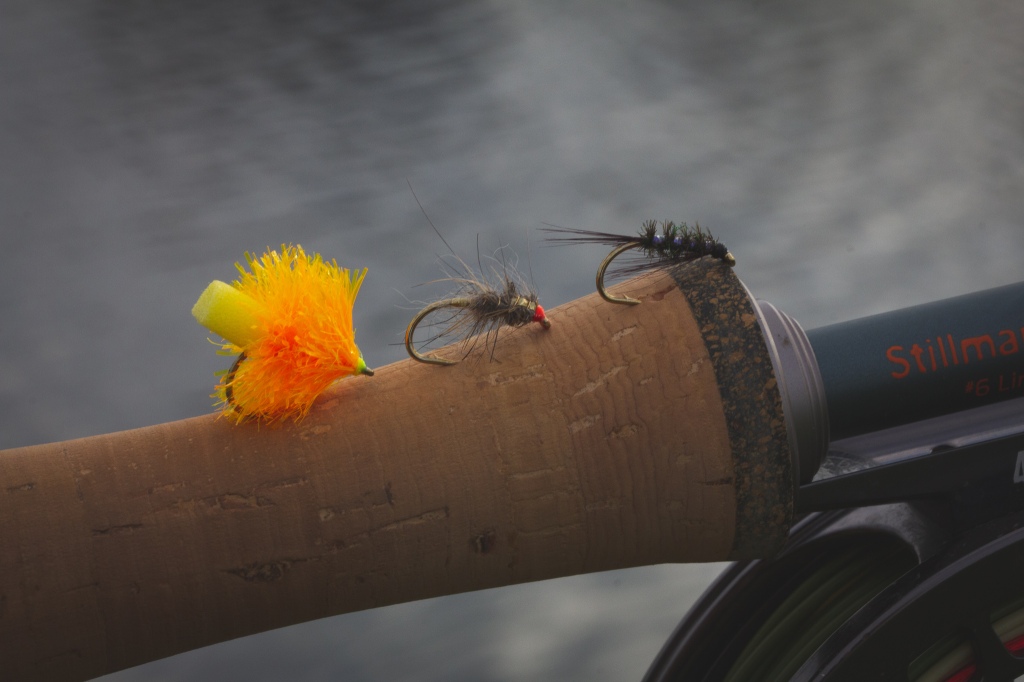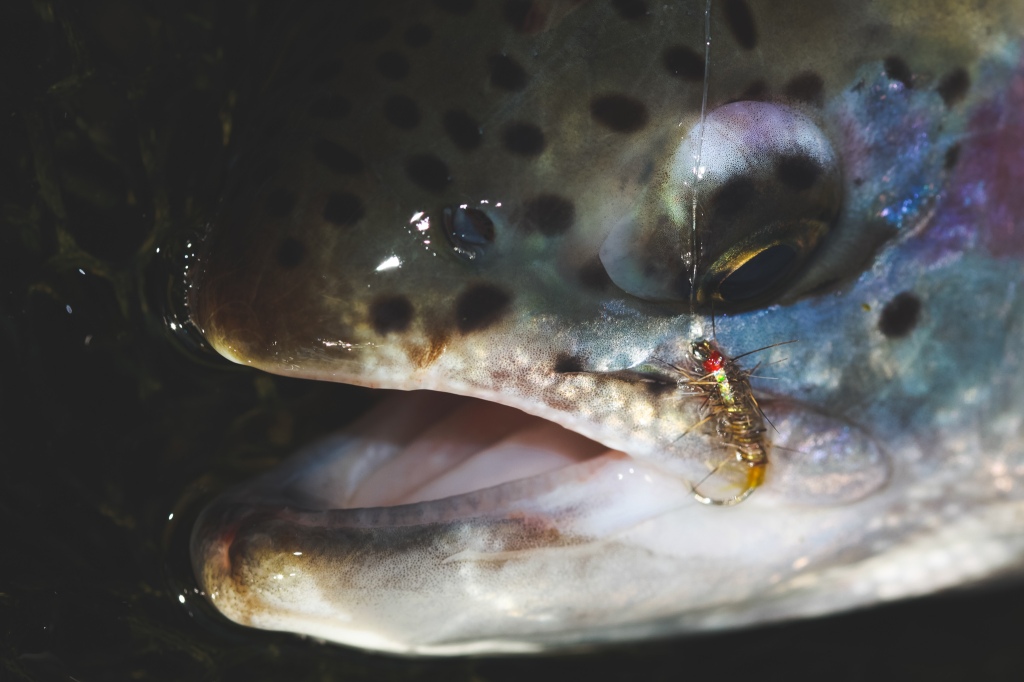When the trout are up in the water, keep those flies just under the surface. In this Blog I share my favourite patterns and why I favour them for this style of fishing.
In the past, November and December would be the ideal time to get out the fast-sinking lines and some weighted lures. The lovely warm weather which we had experienced during the summer months would have given way to cold easterly winds, along with, sleet and even snow. As a result of the change in temperature the water would have cooled somewhat dramatically and the fish, as a result of this temperature change, would be down in the depths.
The cold fronts we experienced would result in a long line of anglers, huddled in their coziest clobber, punching out long casts, using fast-sink lines, rather gaudy lures, and then slowly them bringing back, with a jerky retrieve, in the vain hope that something would pull back.
Not so much these days though..
Things have changed. Even as we come to the end of November the top of the water is where the majority of the feeding is, so, I guess that’s where the trout want to be! When they are up in the water and feeding properly in this manner it allows us to refine our approach and target fish that are actively feeding.
This is what fly-fishing is all about isn’t it, fooling a feeding fish!
BANKERS

I have a team of three flies which I rely on quite heavily when the fish are up at the water’s surface. This team has taken over the usual and much-talked-about ‘Washing line’ which featured that go-to point fly, the Booby!
Going back a while, a decade or so, the FAB, Foam Ass Blob, came to light. It was The Change Flyfishers that made this fly work so well in their favour all those years ago, but soon everyone knew of its fish-catching properties.
Now, the world of competitions fly fishing can be a bit of a cut-throat one, some anglers would sell their own grandmother to get one up on other anglers. As a consequence, there are an awful lot of secret flies, ones in which certain anglers and indeed teams have great faith in. However, like everything in fly fishing soon enough everything becomes public knowledge. Once the FAB was public knowledge then everyone was all over it!
I have been using this versatile (this is the key, it’s versatility) little fly for a very long time now, and I, like everyone else, have caught an awful lot of trout on it. But in my opinion, it’s when the trout are in the top few feet of water, that accurately utilizing this fly, really makes the magic happen. Not only will it hold up the other flies, placed on the droppers – I’ll get to these next – but it catches its fair share of trout too!
For me, the FAB has over taken the Booby as THE point fly when I’m fishing the ‘washing line’ but only when I’m up in the surface layers.
For sunk line work the Booby still rules the roost as it allows the flies to fish in a more aggressive arc, which I like. Maybe I can look into that a little more another time…..
The one FAB pattern which I tend to fish to the exclusion of all others is a Sunburst one, for me it’s better than everything else. I think that the reason that I favour Sunburst, by the way, it has to be a certain shade as I’m fussy, is because it just seems to stands out so well fished up at the surface where there’s more light. It’s a great colour for clear water too, which is usually what we are fishing in during the colder months?

When it comes to tying my FABs, I use a (static) hook, a hook that suits a fly fished slowly, for me, it’s a Tiemco 2499. I make a point of tying in lots of foam at the rear too, and there’s a reason for this. If I start with a lot then I can trim away as I see fit. This allows me to control the descent of the team of flies that I’m fishing. Far better to take away some foam than trying to add buoyancy right? More foam, more buoyancy, and vice versa. I can control where in the water column the flies are presented and I can do all this with a floating line, as long as it’s not too windy of course. I also have the option of varying leader length too, again to allow me to control the depth at which I fish my flies.
DROPPERS
On my droppers, I’m very specific, it’s a Diawl Bach on the top dropper and then a Hare’s Ear middle, nearest the FAB.
On the old DB, you can use whatever variant that you wish but I like one with UV. I’m fishing high up after all and this is where UV comes into its own. I will sometimes chop and change between orange, red, or black thread heads, but the rest of the fly doesn’t change. A plain Diawl Bach but with a UV rib. This style of fly certainly seems to work when it comes to stillwater rainbows!

The Hare’s Ear too is one that has been tied so that it performs well high up in the water. As a fly tyer you need to think about these things when you’re creating flies. Where you’re looking to fish the fly can help when it comes to form and function. As it’s going to be high in the water I like some bling, a little addition that will help it catch the light and hopefully the trout! I also like an orange head, this covers the bases and means that it can be taken as a Corixa as well as all the other goodies that can be found up high in the water.
It is a very simple pattern but at the same time complex, Somber, kind of, apart from the triggers which really seems to appeal to feeding trout, it certainly grabs their attention.

Both my dropper flies share a common theme, they are tied in a manner and with materials that mean they are slow-sinking, keeping them up in the trout’s field of vision. I see it often, anglers targeting the surface layers with the washing line, but using hard-bodies buzzers, flies that will sink below the feeding trout! Don’t do it guys, slow sinking patterns are what you’re after, put some thought into it.
It’s also worth highlighting that I like to tie the dropper flies on size 12 and sometimes 14 and even 16 hooks, a little smaller than the standard size 10’s. Most food at this time of year is small, not big and bulky as is often the case in the summer months.
To keep things simple, fish a straight through leader, if you’re less experienced, go for 4ft to first dropper, 4 to the next and 4 to the point. For the anglers that are a little more into things, increase that to 6ft between flies. As with most things, simple is often more effective!
DRESSINGS
FAB
Hook: Tiemco 2499 size 12
Thread: Any light coloured thread
Butt: 7mm yellow Booby Eyes
Body: Sunburst Fritz, 10mm

Diawl Bach
Hook: Wet fly size 12
Thread: Black, red, orange
Tail and beard: Claret cock
Body: Single strand of peacock herl
Rib: Medium UV

Gilded Hare’s Ear
Hook: Wet fly size 12
Thread: Flu Orange
Butt and cheeks: Flat gold tinsel
Rib: Medium gold wire
Body: Stickle Dub Natural Grey

You can create your own Gilded Hare’s Ear here…

Very good reporting all your information very good well done Steve keep it going
LikeLike
Brilliant, informed blog
LikeLike
Hi Steve,
An interesting and informative blog. N the winter months I usually have a look through my fly boxes and clear out the flies that I think are past their best! I strip the dressings off and re tie on the hooks. I’m tying blobs today so I’m interested in the specific materials you use ( for all 3 flies in the team). Could you please tell me which make of sunburst you use and which uv for the DB?
I have sunburst nd uv but neither looks the same as on your tyings.
Regards
Dave Hockin
LikeLike
Any sunburst,mine’s is old, called Synergy, I bought all of it when the guy retired, it’s UTC UV pal
LikeLike